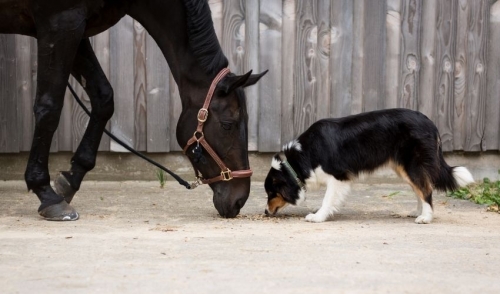
Safely Introducing Dogs and Horses
Whether they are working animals, casual pets, or four-legged family members, dogs and horses need proper introductions to get along. Knowing how to safely introduce dogs and horses can help you keep your animals comfortable with each other in all types of situations.
Why Introductions Matter
A careful introduction is a safe, easy way to get different animals accustomed to one another’s smells, sounds, and behaviors. Without a proper introduction, animals can be skittish and anxious around each other, and may lash out unpredictably, even dangerously. This could cause injuries not only to each animal, but also to their handlers or other animals or people nearby. A good introduction, however, will ease animals into a relationship and begin to build trust between them so there is no fear, anxiety, or stress whenever they come together.
Tips for Introducing Dogs and Horses Safely
Before initiating an introduction between dogs and horses of any age, it is important that the animals are comfortable and at ease in their surroundings. This is especially critical if a new animal has been purchased or brought home, and may already be anxious about a new setting and all the changes it has recently experienced. First allow the animal to relax and get accustomed to its home and surroundings before planning an introduction. When both animals are settled in to the home, they can more easily be introduced.
- Introduce smells first. Before bringing the two animals together, introduce them to one another’s smells. This can be done with a used blanket or toy, or even just the clothes you wear while around each animal. Let them sniff and smell the other animal on you or the object first, so they will associate the new odor with your familiarity.
- Bring the dog to the barn. While the horse has been turned out, bring the dog – on a leash – to the barn and allow it to calmly walk through the facility, sniffing and seeing the space. This can help the dog feel comfortable before it actually meets the horse. This is also an ideal time to begin training the dog to respect off-limits areas.
- Reinforce the training of both animals. Both the horse and the dog should be familiar with commands and the social hierarchy you lead. Reinforce their training to be sure they recognize when to stop behaviors or what spaces are off-limits. For dogs, this should include sit, stop, drop, and stay commands. The horse should recognize commands and signals to stop and stay as needed.
- Keep both animals comfortably secure. When first introducing dogs and horses, both animals should be comfortably secured. For a dog, this will mean being on a firm leash and obeying proper leash etiquette and commands. For the horse, staying in a stall or in an open corral is best so the animal cannot run into unsafe areas, but does not feel too harshly confined, which could create panic or anxiety.
- Use an experienced helper if possible. If either animal is inexperienced with meeting other species, or if there may be a history of poor introductions with other animals, it can be helpful to have an experienced assistant on hand to hold a leash or halter, or to be alert to any signs of difficulty and help intervene if necessary. This should be someone both animals are already familiar with and comfortable around.
- Start with a distant introduction. The first time both animals are together, keep them at a safe distance from one another. Allow them to see and smell each other, but avoid direct interaction at that time. Instead, keep the animals’ focus on you with simple commands and reinforcing positive behavior with treats. If both animals are calm and interested in one another, allow them to approach more closely.
- Go for a nose-to-nose introduction. After the animals have first noticed each other and are curious about one another, allow them to meet nose-to-nose for a sniffing introduction. Stay close by and alert to any signs of trouble, but allow them to casually meet at their own pace. Take care that neither animal becomes startled or reacts impulsively, which could scare the other animal and create a dangerous situation.
- Stay alert to body language at all times. Always be aware of each animal’s behavior and body language, particularly watching for signs of tension, unease, or fear. Do not force the animals together if either one is uncomfortable, and if they do start to get anxious, calmly and quietly separate them and take individual steps to reassure the animal and settle its nerves.
- Always be patient. The first introduction between dogs and horses is bound to be relatively brief, and it may take some time before the animals are completely at ease with one another. This is perfectly natural and expected, but do not force them to be together for long periods if they aren’t relaxed and comfortable together. It may take several short meetings before they can start to be together for longer periods, but eventually dogs and horses can become fast friends.
It can take some time to introduce dogs and horses properly, but with safe, reassuring practices, these two very different animals can learn to get along and may even become close companions. Always being safe with introductions and fostering mutual respect – with you as the leader of a very diverse pack or herd – is a great way to bring dogs and horses together for relationships you will all enjoy.
